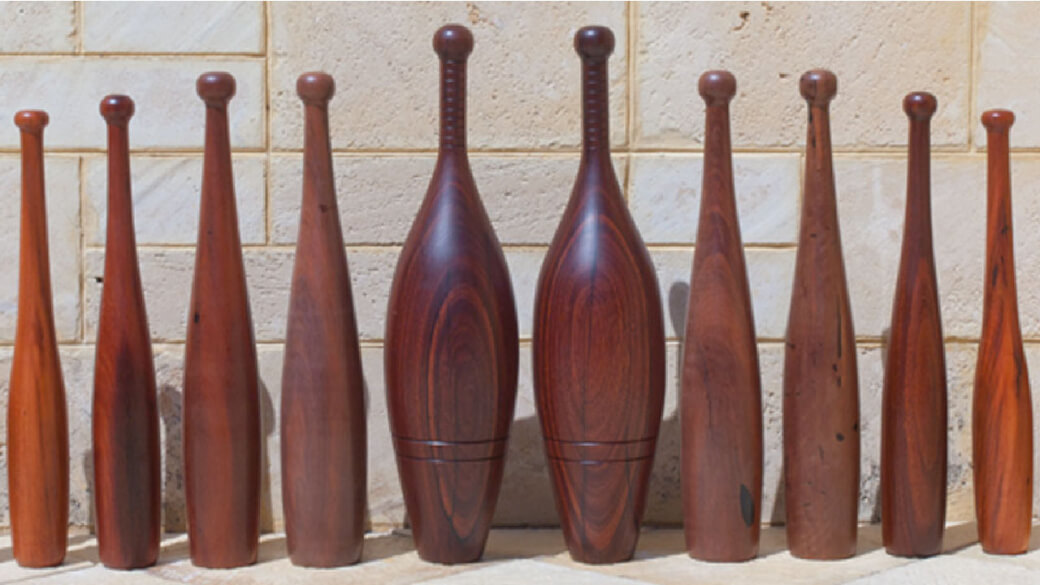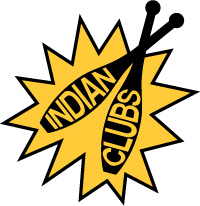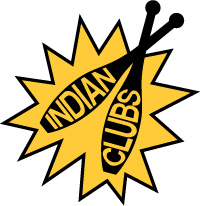Art of Swing
The art of swinging clubs was used as a staple of fitness training long before it reached Europe in the early 1800s.
Indian and Persian Culture
Club swinging was part of Indian and Persian culture and was practised by wrestlers, soldiers, police and others as part of their daily fitness routine. The ancient clubs were simple in shape and were swung in basic movements helping practitioners gain flexibility, coordination and upper body strength.
Efficient Exercise
The excellence of club swinging was noted by English troops stationed in India, club exercise was deemed to be so efficient that it was adopted by the army for use as part of their daily exercise drills.
Fitness Training
English soldiers returning from India brought the simple, yet effective equipment known as Indian Clubs back with them to England where they were quickly adopted by civilians for fitness training.
America
An American gentleman named Sim D. Kehoe, a physical fitness enthusiast visited England in the early 1860s. Kehoe witnessed the Art of Indian Club Swinging in London and seized the opportunity to take the newly found exercise apparatus back to America where he began to manufacture and sell the clubs to the public.
Revived Interest
Art of Swing became a very popular fitness and exercise system based on the use of wooden clubs of various weights and sizes. Today Indian Clubs are enjoying revived interest.





Hi Taras.
Thanks for the web site and the videos you have put on youtube, you have helped revive and widen my interest in club swinging!
I have used it in the part as a warm up exercise for juggling which used to be my profession. I was aware of some of the history of the art and that club swinging was imported from India to England with the troops who were stationed there during colonial times but I was never aware of the tradition of Iranian and Persian club exercise. It is great that it is so easy now to look things up on Youtube and the internet and actually SEE people doing these things.
I also saw some clips from America of old time strongmen and even kids exercising with clubs. Some of the clips from Iran included ‘strongmen’ actually juggling with heavy clubs, throwing and catching two in one hand, quite impressive.
I think it would be fair to assume that the development of juggling with clubs, which are traditionally shaped in the same way as swinging clubs must have grown out of the popular swinging excercises. I can easily see how some enterprising juggler thought up the idea of making a light weight club that would be more suited to throwing and catching and less likely to do mortal damage if a mistake was made and at the same time being able to impress a public who would naturally assume the (then) more normal heavy clubs were in use.
The other thing that stuck me looking around the mentions online on various sites and on YouTube is that no one (that I have found) seems to make the link between old time club swinging and the use of clubs in modern day rythmic gymnastics. In a way I can see whay as the modern form has little resemblance to the ‘old school’. In a way there is more of a link with juggling as the performers, nearly alll young girls spend most of their time throwing and catching the clubs.
At the same time it seems pretty obvious that the tradition is from club swinging as there is only two clubs and there are a few move that are obviously ‘swinging’ moves and the clubs and manipulated one in each hand. There is also an obvious link with the actual shape of the clubs in use as they are almost identical with the type of light weight club that I’ve seen illustrated in old club swinging manuals, usually designated for use by beginners, children (and ‘ladies’ !).
I am particularly interested in the more unusual swinging traditions that you demontrate, the mace particularly, I saw one little clip on YouTube of someone else in India demonstrating one but your clip was the first I have seen.
I have one book on Club Swinging called ‘Indian Club’ by E. Ferdin Lemaire which is very old and in bad condition but appears to have been published in 1890. You may know it, most of the book is made up of rather repetitive descriptions and diagrams but there are a few interesting sections at the back on Strongmen.
I’ll wind up this rather long comment now but if you want to get in touch, please do, I’m interested in the history and revival of this, almost lost art. I’m just starting to get back into shape using interval timing in combination with club swinging, it seems to work well.
Thanks again for your work on the site and the videos, thay have inspired me to get out of my chair and start swinging again!
best regards Dave (Spathaky)
Ireland
Where can I purchase the 4.5kgs?
Hi Taras
Great video on the combination exercises. I’ve just started with Indian Clubs and I ordered a set from Mike in Sheffield. Unfortunately I chose a set which was too heavy at 2.4kgs. I had based this size on the kettlebell exercises I had been doing with a 4kg weight and a bar at 12 kgs. I ought to say I’m 67 so I can’t go too crazy, and I’ve recently given up the gym as it’s too expensive now. Mike did tell me the weight distribution with the clubs is entirely different, which I now realise. He is kindly allowing me to replace the clubs for a 1 kg set which I’m sure will suit me better. I’ve been using a really light set made in Beech wood at 1/2 kg each, but these are just a bit too light. But I have to say I find the basic exercises from Kehoe’s book extremely exhilerating and much more focussed than lifting weights in the gym. I’m really using the clubs to keep me supple for Lawn Bowls and they work very well. So, looking forward to getting the replacements and getting to it.
Regards
Charles
Hi Charles
Once you get really focused on movements with Indian Clubs, you will find a mass of variety, which will keep you fit and the brain working out the moves as you do them. I have to tell you that I have just turned 63, have been swinging clubs for the last three years, and found my mobility and strength has vastly improved.
Think you were very wise to go down in clubs size, as you now know it’s not the weight that is important but the movement with weight displacement. If you ever consider a heavier club, somewhere between 300 to 600 grams heavier is plenty, and will give you a great workout performing the same exercises from Kehoe.
Mike Simpson makes a great range of Indian Clubs by the way, I have a pair of his Military Clubs No4, and they are a real delight to swing.
If you have a moment maybe you would like to have a look at some of my videos. Goto
http://www.youtube.com/user/taraswolkowinski?feature=mhee
Best Regards
Paul Taras Wolkowinski
Thanks Taras. I’m just waiting for the heavier clubs and I’ll let you know how I get on. I can work out for an hour with my light clubs, but I do find co-ordination a bit difficult. I wonder if, when you do another video, if you could put in some numbers. I have trouble remembering what you are doing when I try to copy and a numbered sequence might just help. This is really a very interesting form of exercise.
Hi Charles,
Thanks for the suggestion, I will try to create a prompt system on the next video. I usually have to write everything down an a white board in big lettering to remind myself. I am getting better at remembering routines, I do understand the difficulties remembering the sequence of moves and will work something out. You are right when you say that this is an interesting form of exercise, it certainly has me captivated.
I’ve had a workout with my 1kg clubs for an hour and it was the right thing to do to change – these are much more manageable for me. What I find strange is that I don’t feel any pulls or strains after club exercise in my shoulder muscles, despite the fact I’ve only been using the smaller (1/2kg) clubs for a short time. Admittedly, I worked with small weights and a 4kg kettlebell in the gym before transferring to clubs, so I suppose I’m benefiting now. It seems to me there is a certain feeling of elation after finishing the exercise, probably because of the mental requirement for concentration which is not so intense in weight lifting in the gym.
I’m working on the individual elements of your routine as I really like what you are doing. I think the hardest part is the individual mills when you pause one hand, and I can’t really see how to start this process. The constant movement of the non-milling club in the pendulum arc action across the body is giving me a problem because it wants to go off on a different path. My co-ordination is nowhere good enough yet, but that exercise is a real challenge. Any hints appreciated. Regards, Charles
Hi Charles
Kettlebells do wonders for the shoulders and would have laid a great foundation. I agree that the mental focus and exercise combine do give a feeling of elation.
Can I suggest that you work on the arm that is failing, in short bursts, slowing the movement right down and don’t get frustrated. I have to do this all the time, I can perform certain moves very well in one direction and fail when I reverse it in the opposite way. If possible find a spot where you can see your reflection, be it a mirror, or a window if you are outside. Your reflection will help you see where you maybe going wrong. Apart from that it’s practice that makes you perfect. I am planning a series of Back to Basics with Indian Clubs and will revisit the transition for you bearing in mind your comments.
Hi Taras
Thanks for the reply. I actually managed to complete your routine this week,although it’s certainly not as slick as the way you do it. But I can move from one movement to the next and I’m beginning to see how it should be done. I have to work outside in the garden – the space for swinging is too much for anywhere inside my house, and the weather is atrocious in the UK at the moment with snow. But I can see reflection in the conservatory window, and, as you say, this helps. I, too, have trouble with the reversals, it seems I lose the pattern of the move in my head and I can’t figure out the direction the club should take to get into the mills behind my head. I can sustain an hour’s exercise in each session, warming up with the 1/2 kgs for fifteen minutes. This is much longer than anything I achieved in the gym and I think much more interesting as a mental exercise in concentration. I bought Mike’s CD on the early military moves and these offer another challenge to work into the routine – it certainly makes things easier to follow than de-cyphering the book diagrams. Looking forward to seeing your Back to Basics series and I know these things take a lot of time to prepare, so perhaps you can drop me an email when you have something on Youtube. Regards, Charles.
Hi Charles
That’s great that you have mastered the sequence. You just have to persevere with reversals. If I am having an issue with something, I will split my time and work the problem area double hard, usually my left arm with determination, speeding up, then slowing down to almost slow motion, making sure that my hands are where they should be and I am not being sloppy. A lot of the moves I have learnt come from those old diagrams, it’s akin to working out a complex puzzle.
Have you subscribed to my Youtube channel? I will definitely let you know when the videos have been posted.